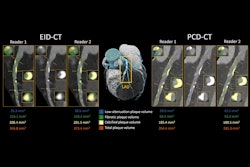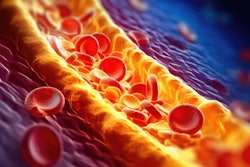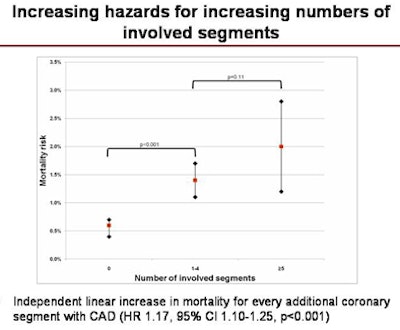
Asymptomatic adults with a low Framingham risk score (FRS) and nonsignificant coronary artery disease still face a higher risk of death and adverse events if mild coronary artery plaque is present at coronary CT angiography (CCTA), according to a study from Cedars-Sinai Medical Center in Los Angeles presented at the 2011 American College of Cardiology (ACC) meeting.
In more than 18,000 asymptomatic individuals with nonobstructive coronary artery stenosis less than 50%, the risk of death and cardiac events was far higher than in patients who tested negative at CCTA, the investigators said.
The focus on nonobstructive plaque is new territory for CCTA, lead researcher Dr. James Min told AuntMinnie.com. Until recently, evaluating the accuracy of coronary CTA has been limited to the detection and exclusion of obstructive coronary artery disease (CAD). But recent studies have highlighted the ability of CCTA to identify mild forms of atherosclerosis, as compared to intravascular ultrasound.
In addition, autopsy studies have implicated nonobstructive CAD as central to the pathophysiologic processes of sudden cardiac death and myocardial infarction, he said. Still, whether CCTA plaque assessment in individuals without obstructive CAD enhances risk prediction has not been well examined, Min said.
Therefore, the study aimed to examine the predictive value of nonobstructive CAD extent and severity as detected by CCTA for intermediate-term mortality risk among patients referred for suspected CAD, Min said. Study data were compiled from the Coronary CT Angiography Evaluation for Clinical Outcomes: An International Multicenter Registry (CONFIRM) results. CONFIRM enrolled 27,125 consecutive adults 18 years or older, who received CCTA exams for suspected CAD on scanners with 64 detector rows or more at Cedars-Sinai and 12 other centers in the U.S. and Europe.
The researchers prospectively gathered data on risk factors for heart disease, including hypertension, diabetes, dyslipidemia, smoking status and history, and family history of CAD.
Coronary CTA scans were performed on a variety of CT scanners including LightSpeed VCT (GE Healthcare), Somatom Definition (Siemens Healthcare), and Somatom Definition Flash. Parameters included 64 x 0.625 or 0.750-mm collimation, 100- or 120-mV tube voltage, and effective 400 mA to 650 mA. Dose reduction techniques included electrocardiogram (ECG)-gated tube current modulation, reduced tube voltage, and prospective axial triggering employed wherever feasible. Total estimated radiation dose for CCTA ranged from 3 mSv to 18 mSv.
All scans were read by highly experienced cardiologists, who scored the images for the presence of plaque using a 16-segment coronary artery model. Stenosis severity was scored as none (0% luminal stenosis), mild (1% to 49% luminal stenosis), moderate (50% to 69% luminal stenosis), or severe (≥ 70% luminal stenosis), Min said.
Plaque severity was graded per-patient, per-vessel, and per-segment, based on the maximum severity in any segment:
- For U.S. patients, the team examined death by all causes, verified by the Social Security Death Index.
- For both U.S. and non-U.S. sites, death or myocardial infarction was verified by clinical visits, telephone contacts, and questionnaires sent by mail. Verification of all reported events was taken from hospital records or from direct contact with a patient's attending physician.
- Events occurring less than 90 days after the index test were excluded from analysis.
Patients with either moderate or severe stenosis were also excluded from the analysis, leaving 18,037 patients with stenosis of 50% or less in the cohort that was followed for 2.3 years (± 1.1), according to Min.
 |
| The above chart shows numerical values for increasing risks of cardiac events in the presence of one or more coronary artery vessels; a graphic representation of similar data is shown below. All images courtesy of Dr. James Min. |
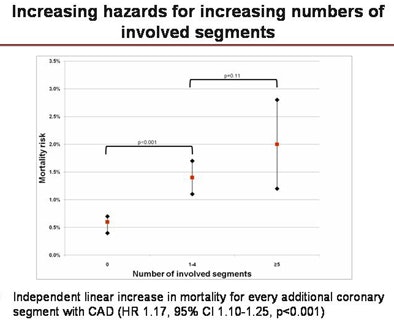 |
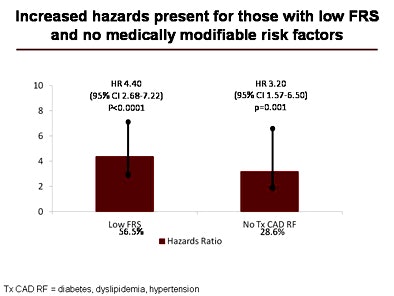 |
| The risk of adverse events for patients with nonobstructive coronary artery disease remains elevated even for patients with a low Framingham risk score and no modifiable risk factors. |
 |
| Unadjusted Kaplan-Meier curve shows decreasing survival over 2.3 years for each additional vessel with nonobstructive coronary artery plaque. |
"In a large, prospective, multicenter CONFIRM registry, the absolute presence and extent of nonobstructive CAD by CCTA is predictive of incident adverse events, including death and nonfatal myocardial infarction," Min said. "The prognostic value of CCTA findings in patients with nonobstructive CAD applies even to patients with low FRS and patients with no medically modifiable CAD risk factors."
On the other hand, the absence of CAD by CCTA is associated with a very favorable prognosis -- just 0.27% events yearly, he said.
CCTA as a gatekeeper may permit a reduction in "unnecessary, unhelpful, and unsafe diagnostic invasive angiography ... and uncouple the diagnostic-therapeutic cascade," Min said.
Future studies examining the treatment of patients with nonobstructive CAD by CCTA are necessary to refine treatment protocols for these patients, he added.





